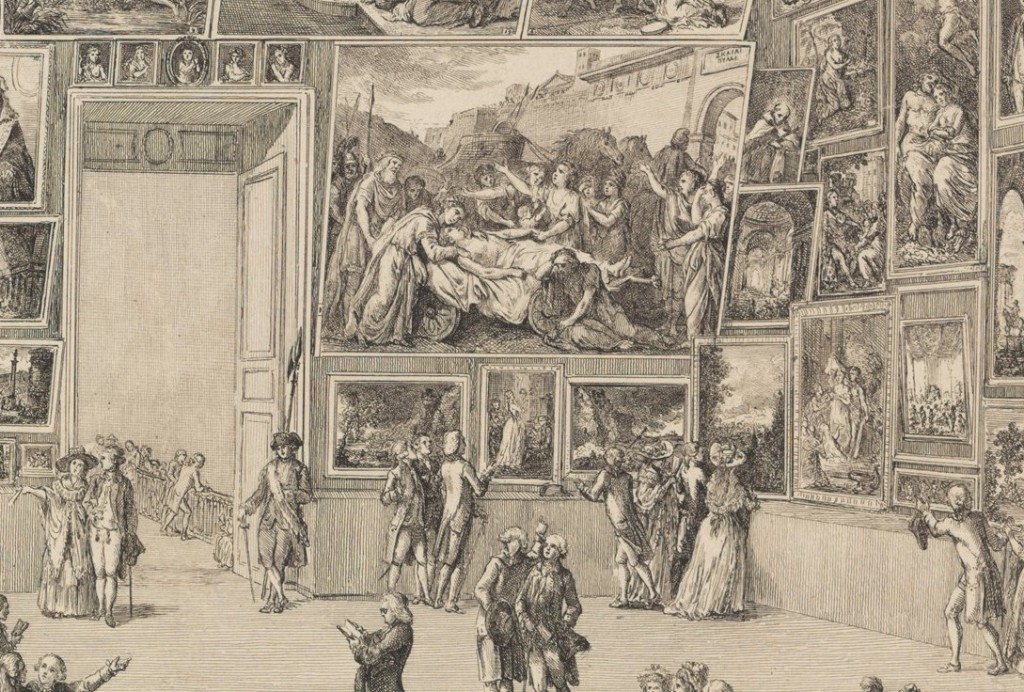Charlotte Guichard
“Leave my cane! Leave my cane! Then how do you expect
me to poke holes through the oil paintings?” [1]
— Mark Twain
In the Villa Farnese at Caprarola outside of Rome, Renaissance frescoes are covered with examples of centuries-old graffiti. Among these disruptive additions, scrawled in graphite, is a signature or “tag” made by the young French painter Hubert Robert (1733-1808) during his stay in Italy: “Roberti/1764” (Fig. 1). Hubert Robert indeed visited the Villa Farnese: there he made red chalk drawings and painted the famous spiral staircase designed by the Renaissance architect Jacopo Barozzi da Vignola (Fig. 2). By signing “Roberti,” the French artist Italianized his name, adopting the same letters he had used four years earlier in the double signature of his painting Laundress and Child (1761, Clark Art Institute in Williamstown, MA). For some reason, Robert chose to leave a material trace of his presence in Caprarola, this place where he studied and emulated Renaissance frescoes and architecture. Moreover he signed his name within an encircling form that echoed and paid homage to the curved shape of its staircase. In so doing, Robert underscored not only his years of training as a future painter of architecture and ruins but also his attentiveness to architectural forms and shapes.
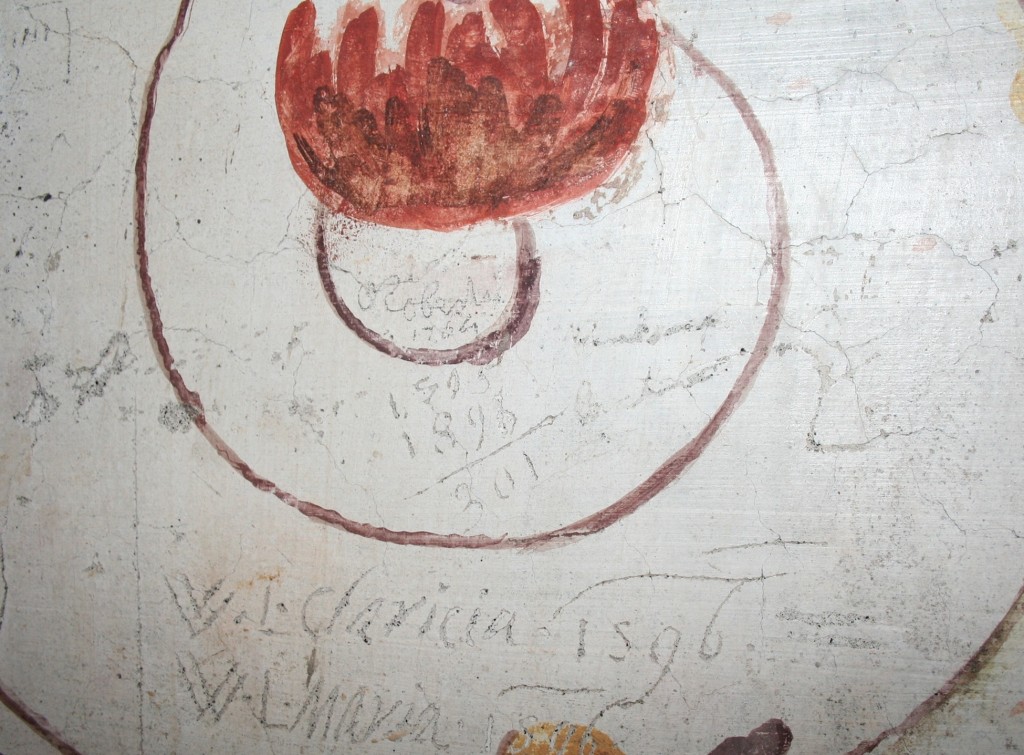
Fig. 1. Graffiti “tag” left (in the center of the image) by Hubert Robert in 1764 at Villa Farnese, Caprarola. Photo by the author.
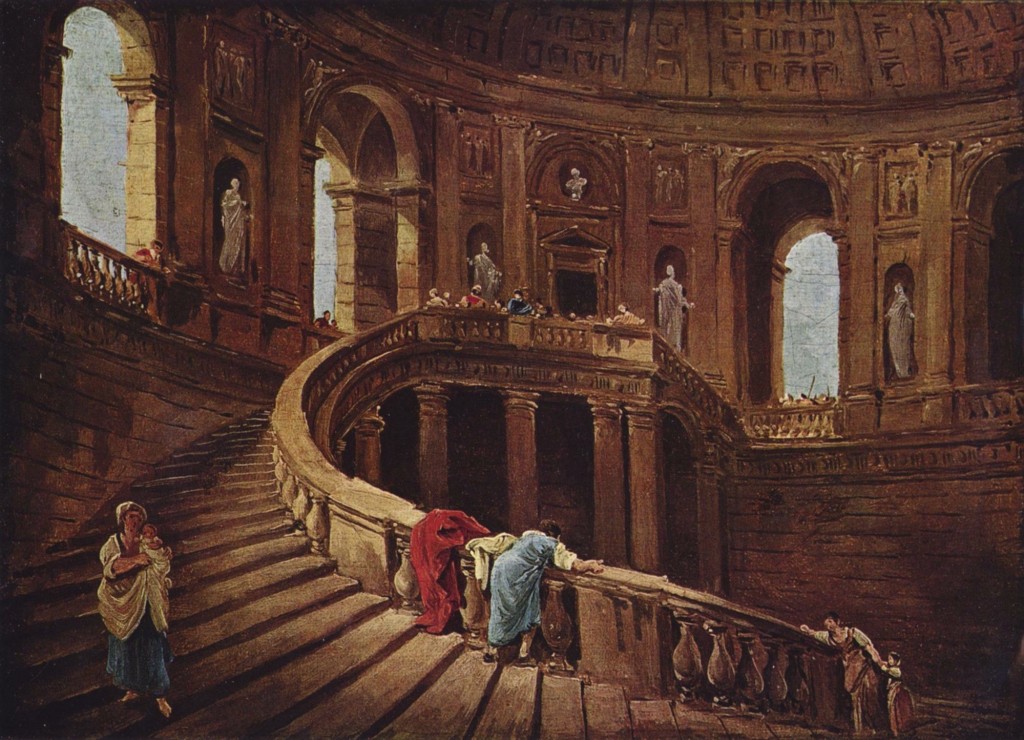
Fig 2. Hubert Robert, Staircase in the Palace of Caprarola, oil on canvas, 25 x 34 cm, 1764. Paris, Musée du Louvre. Image: Wikimedia Commons.
This instance of graffiti is not alone: we can find many similar tags by Hubert Robert as well as other artists and travellers in early modern Rome. Rarely taken into account, and sometimes not even mentioned, these graffiti traces have been considered at best as “curiosities” or at worst as gestures of vandalism, as in the case of the graffiti made by the troops of Emperor Charles V during the sack of Rome in 1527.[2] Other graffiti remaining from the Middle Ages and early Renaissance, especially on the walls of churches, have been generally analyzed as traces of devotional practices, embedded in broader ritual behaviors.[3] In this article, I adopt a contrasting view. While we know that the development of art during the Renaissance as a specific realm of social experience borrowed some of its features from the field of religion, I do not consider eighteenth-century artists’ graffiti as a late avatar of religious attitudes to art and images. Rather, I consider them as performances of authorship and as a site of reflexivity on artistic practices.
Eighteenth-century artists’ graffiti, I argue, testifies to forgotten modes of relating to art in the early modern era. Tags and signatures appear on a wide variety of subjects in many venues: on the ancient frescoes in Hadrian’s Villa in Tivoli, which attracted architects from all over Europe during the eighteenth century; on Renaissance frescoes painted by Raphael (Vatican Palace, Villa Farnesina, Villa Madama); and on later frescoes such as those in the Carracci Gallery in the Farnese Palace (1597-1608). These sites were already heavily visited in eighteenth-century Rome, attracting travellers during their Grand Tour. They especially appealed to artists, since Rome was a privileged destination for artistic training in the eighteenth century. The primary foreign academy in Rome at the time was the French Academy, founded in 1666 as a satellite of the Paris Académie royale de peinture et de sculpture. Young French artists who won the Prix de Rome were sent there to study the artistic canon in situ.
What interpretation can we give of such seemingly interventionist gestures that involve artists carving their names on masterpieces that they did not themselves create? I consider this graffiti as an archeological trace of a certain relationship to art in early modern Europe, one that has since been erased, even repressed, in the age of the museum. With the birth of the museum (a development accomplished in Europe by the middle of the nineteenth century) a modern conception of artistic heritage was established that carried with it a new contemplative relation to art. From that time on, art was to be observed and admired from a distance.
Before that age, the graffiti of early modern Rome records gestures – not commented on in traditional sources – which suggest that physical encounters with art in this period encompassed a far more personal and intimate tactile experience. Examining these gestures, we discover an artistic canon created not only through books and theoretical treatises. Instead, we find that affiliation and admiration could be written onto the surface of art itself. In the case of artists, this haptic experience was highly significant, for many of them visited Rome during their own years of artistic formation. They were obliged to copy Antique and Renaissance paintings and sculptures in order to develop their taste and become familiar with the great models held aloft by the Académie royale. These copies were then sent to Paris to be housed and exhibited in French royal collections. But often, before that, these artists had inscribed their names on the original artworks they studied. As such, the practice of copying was related to notions of physical contact and imprint, two concepts that have been largely ignored in the recent historiography of art. Why sign another artist’s work with one’s own name? This question, I maintain, situates these examples of graffiti within a history of artistic authorship. I propose to weave together traditions of graffiti and signature through the history of early modern painting and to demonstrate how both were important sites of artistic expression and self-definition.
Experiencing Art: A Monument of Signatures in the Vatican
Raphael’s series of frescoes from the so-called Heliodorus Room (1511-1514) of the Vatican Palace were frequently copied by artists during the early modern period. Already upon its completion, the series was considered a perfect example of Raphael’s work. Artistic academies in the seventeenth century elevated it even further as an exemplary model of the Classical ideal. Under one of the room’s frescoes, The Expulsion of Heliodorus from the Temple (c. 1512), stands a massive fireplace, its mantel covered with names of artists carved into the marble. The first artist to leave his signature was the French painter Nicolas Poussin (1594-1665), today considered the founder of French Classicism, who included his name with a date: “poussin 1627.”[4] One century later, the French painter Louis-Michel Van Loo (1707-1771), who was studying in Rome at the time, rediscovered Poussin’s signature on the fireplace and added his own name along with a date of “1729” (Fig. 3). During the course of the century, these graffiti tags proliferated. Names became particularly numerous in the 1730s, when the fresco was copied by many French artists and seen by important individuals, all of whom left their names: Noël Hallé, Louis-Joseph Le Lorrain, Hugues Taraval, and others. A total of sixty-six signatures have been found on the fireplace.
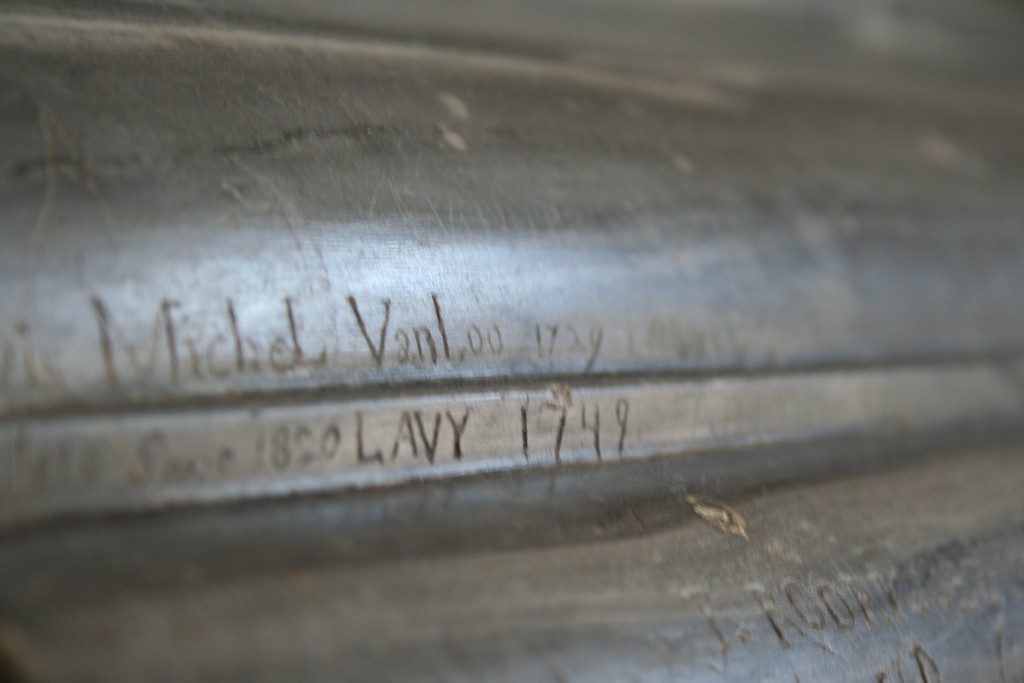
Fig. 3. Louis Michel Van Loo’s signature from 1729 carved into the marble mantel in the Heliodorus Room, Vatican Palace, Rome. Photo by the author.
Why choose marble for the inscription of these names? Marble was not a common stone but rather a noble material regularly used for monuments, especially for monuments to “Great Men,” during the eighteenth century.[5] The graffiti left by these artists was thus highly performative, transforming an ordinary marble fireplace into a shrine to Classicism, or a memorial erected to Raphael and Poussin. Poussin asserted an affiliation with Raphael in 1627, a gesture that was then imitated by artists who came after him in the eighteenth century. By inscribing their own names next to Poussin’s signature and below Raphael’s fresco, they affirmed a connection to both artists.
Such a testament to Poussin was by no means obvious in the eighteenth century. At that time, Poussin was not yet considered the founder of French Classicism, for his name was claimed simultaneously by both the French and Italian Academies.[6] The Italian Poussin coexisted with the French Poussin. Indeed, although he was born in France, Poussin spent most of his life in Rome, where he died in 1665 and where he is still buried. In the seventeenth and eighteenth centuries, Poussin was considered a major artist – the true heir of Raphael – and both nations claimed his works for their respective schools. It took time for the Académie royale to reclaim the artist definitively for France and to position him as the mythical origin of French Classicism. These artists’ and viewers’ inscriptions were thus not merely the personal jokes of students and travellers who enjoyed more liberty than others in front of such masterpieces, but instead demonstrate how political and proto-nationalistic the creation of the Classical canon would become in the eighteenth century. This monument was clearly intended to be patriotic: almost half of the signatures are French, and one signature by the Polish painter Ferdynand Pinck (1761-1797) has been erased. (It is the only one, though, and other graffiti by Italian artists remain.) By affiliating themselves with Raphael and Poussin, French artists and visitors of the eighteenth century inscribed the idea that French Classicism had successfully appropriated the tradition of Roman Classicism and transferred it to Paris, where all the young artists of the Académie de France in Rome eventually returned. Over time, these individual instances of graffiti collectively claimed that the capital of Classicism was no longer Rome but Paris.
This “monument of signatures,” as I propose to call it, invites us to look at graffiti not as signs of transgression but, on the contrary, as signs of artistic affiliation. Graffiti narrates encounters with artworks: these marks constitute a permanent trace of the material and social life of art as artifact.[7] They show how early modern visitors and artists were engaged in a tactile and intimate relationship with original works of art, not simply driven by an intellectual or philosophical appreciation of beauty as an artistic ideal. Until the eighteenth century, experiencing art was not only about viewing, it was also about performing: visitors (especially artists) were dynamic and active. They had not yet been transformed into the static “observers” of nineteenth-century European art museums.[8]
To inscribe his name on the mantel, Poussin had to kneel down. And to rediscover Poussin’s signature on the fireplace, Louis-Michel Van Loo had to get very close to the fresco. In order to discover it, Van Loo really needed to scrutinize the surface of the painting, to confront it in all of its materiality and thickness. Artists’ graffiti involves both a prolonged corporeal engagement with the artwork as well as an active, dynamic appropriation that is poised both to copy and to create. Very often graffiti was drawn with red chalk or carved with sculptor’s instruments: in other words, done with artists’ traditional tools. Such a haptic mode of relating to art was very different from the auratic performance of the masterpiece that prevails today in museums. The practice of tagging artworks never completely ceased, but its intensity diminished considerably between the end of the eighteenth century and the middle of the nineteenth century, at which time tags and dates became increasingly scarce on Roman frescoes.
This development coincided with the rise of a public awareness that such artifacts needed to be preserved and protected. As a result, masterpieces were placed at a distance and visitors were transformed into “viewers.” Pietro Martini’s etching View of the Salon at the Louvre in 1785 (Fig. 4) shows the new parapet erected at least in part to protect the paintings on the walls from the proximity of crowds. The bookseller Siméon-Prosper Hardy even noted in his Parisian journal that armed guards were positioned by the parapet “at a reasonable distance from one another, ready to curb the indiscretions of any connoisseurs” (Fig. 5).[9] By 1798, more rules were in place. That year the Salon livret noted that visitors were requested to store at the entrance any items that could potentially damage a work of art. On the landing of the great staircase, visitors were advised they would find “attendants of the museum with whom one can entrust with confidence canes, swords, coats, and umbrellas, which must be surrendered before entry.”[10] In stark contrast, examples of graffiti from the early modern period conjure an experience of art that pre-dated the invention of the museum and the new values subsequently placed on material objects and cultural heritage.
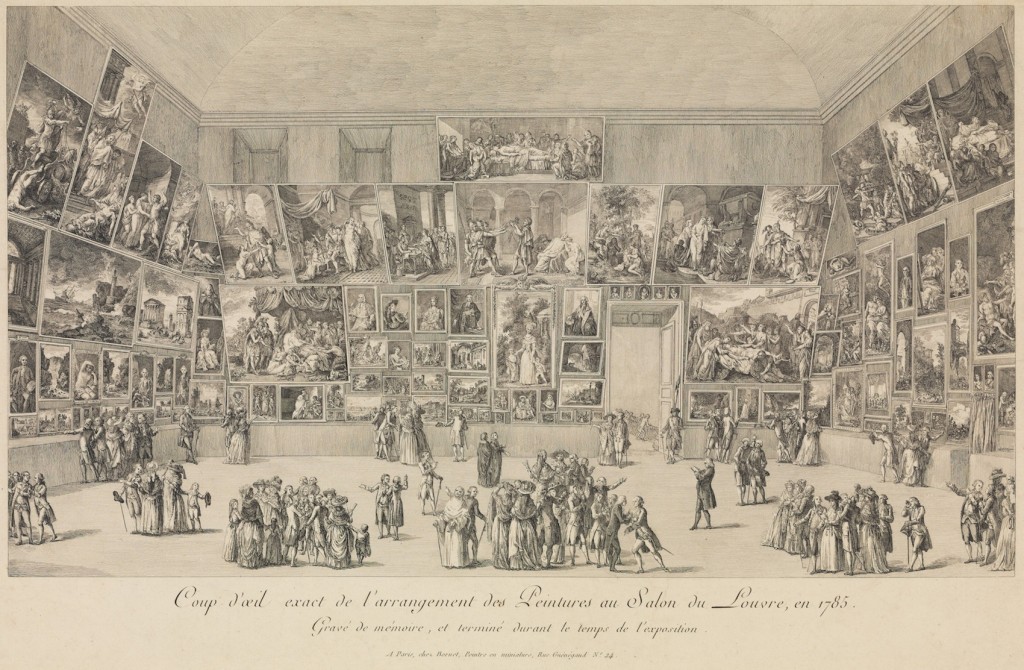
Fig. 4. Pietro Antonio Martini, View of the Salon at the Louvre in 1785, etching, 276 x 486 mm. A. Hyatt Mayor Purchase Fund, Marjorie Phelps Starr Bequest, 2009, Metropolitan Museum of Art, New York. © Image courtesy of www.metmuseum.org.
Indeed, early forms of patrimonialization (that is, the transformation of cultural products into a society’s heritage) remained ambiguous through the eighteenth century, until the institution of the museum brought a different mode of relating to art and artifacts of the past. A drawing by Hubert Robert shows, for example, an Antique statue being sawed from its pedestal in the eighteenth century. Artists did not hesitate to manipulate or change the material integrity of artworks in order to reuse them in their own creations. Such practices were commonly accepted as spolia (the repurposing of monuments) during Antiquity and even the Renaissance,[11] but they also continued throughout the eighteenth century.
In the Emperor Nero’s Golden House (also called the Domus Aurea, next to the Colosseum in Rome), the surfaces of Antique frescoes bear traces of intensive updating by successive artists from the Renaissance onwards.[12] As such its walls reveal the ubiquity of graffiti from the sixteenth century to the end of the eighteenth century. Buried under ruins and ancient remains, the Golden House was rediscovered in the 1480s, during the early phase of the Italian Renaissance. When its grottoes were excavated during the sixteenth century, antiquarians and artists were shocked to discover the images painted on the walls, which they called grotesques: floral swags, painted architecture, and composite figures that were part-animal and part-human. Although they are now badly damaged, one can still make out certain details of the iconography of these frescoes, such as a winged horse.
Today we are granted a striking archeological view of these surfaces as palimpsests. The inscribed dates indicate that these frescoes were updated by artists from 1519 to 1788. The latter date suggests the time period around which they ceased to be a formal reference for artists and disappeared from their agenda. Artists and visitors inscribed their names in many different ways, for, as literary historian Juliet Fleming has shown, graffiti is closely associated with the art of writing.[13] Thus we find words scorched from the black smoke of the torches used by artists going down into grottoes and caves; letters traced in graphite taking the form of a cartellino from the beginning of the sixteenth century (just like Venetian signatures of the same period); and lines of red-chalk and ink forming cursive letters from the end of the eighteenth century. By inscribing their names, visitors sought to leave a record of their presence in these Antique and subterranean remains. But that was not all: these traces were also material appropriations. Antique frescoes were not only copied, they were appropriated, claimed by artists who had no hesitation in signing their own names upon the works of others. When considered as performances, acts of graffiti update and revivify artworks, inscribing them into the present, and – thanks to the dates that accompany them – making manifest multiple temporalities. Material surfaces, then, give a sense of temporal thickness: the temporality of art is revealed not to be a gradual cumulative process but rather one made up of successive shortcuts, temporary oblivion, updating, and rediscovery.
Copying: Contact and Imprint
Can we push this interpretation even further and argue that artists’ graffiti documents the procedures and operations of artistic creation, that is, the relation between imitation and invention, copy and creation? In an exhibition entitled L’Empreinte (Imprint) that took place at the Centre Georges Pompidou in Paris in 1997, French philosopher and art historian Georges Didi-Huberman argued that humanist theorists of art, among them Giorgio Vasari, had repressed all consideration of the copy as a mechanical process.[14] Humanist and Classical art theory indeed placed a high value on copy and imitation, but this was not supposed to be slavish (servile in French). Instead it was meant to be free: the hand of the copyist had to be guided by the eye, and this imitation ultimately led to new models, to invention. This idealization of copy and imitation, intertwined with the Classical theory of invention, was essential to the recognition of the visual arts as liberal (and not merely mechanical) in early modern Europe.
Yet, Didi-Huberman demonstrated that artists never actually dispensed with casting, imprinting and firsthand contact in the process of creation, from Donatello’s sculptures in the Quattrocento to Marcel Duchamp in the twentieth century. In his bronze sculpture of Judith and Holofernes (1460), for example, Donatello cast the heroine’s veil directly from actual fabric dipped in wax, rather than modelling it in clay beforehand as was conventional. Didi-Huberman calls this procedure “imprint” or a “molding image.” According to his interpretation, the notion of “imprint” or “molding image” (L’Empreinte) offers a model for what he calls a “counter history of art” (using the metaphor of the counter proof, as in molding). Graffiti in eighteenth-century Rome can also be viewed as part of this counter history. By adding graffiti to artworks, young artists tasked with copying masterpieces put their stamp or imprint on them, thus leaving behind a trace of intimate contact with the original image. In some cases, graffiti even documents operations of tracing (calque). Here artists are dealing with two opposite impulses: taking (the imprint, the tracing) and leaving (the graffiti). Such operations are rarely documented or discussed because they do not fit into the conception of artistic production as a liberal endeavor, that is to say, as an intellectual process of disegno.[15] However, graffiti attests that acts of tracing were more common than such an idealizing history of art suggests.
The method of tracing was indeed used in the case of the Raphael Rooms. One French traveller to Italy, Joseph-Jérôme de La Lande, wrote specifically in his Voyage d’un François en Italie that the young students at the French Academy were “busy in 1740 tracing by veil (calquer à voile) these beautiful paintings in the Vatican, and painting them afterwards, to serve as models for tapestries.”[16] As noted above, among the artists who left their names on the mantel under Raphael’s Heliodorus was Louis-Michel Van Loo. Van Loo had received an order to make a copy of the fresco for Louis XV, who wanted to use its iconography for a tapestry to be executed at the Manufacture des Gobelins. Engaged in such endeavors, artists perched on high ladders simply traced the original Raphael, then carved their names into the fireplace underneath the fresco.
Of course, not all copies were made by tracing the original. But this example nevertheless demonstrates the importance of tactility and contact in the experience and knowledge of art in the eighteenth century. It reveals that artistic invention rested upon technical or manual operations such as tracing and imprint. Such practices are missing from a historiography of early modern Western art. Investigating graffiti, by contrast, offers an alternative approach: by scrutinizing the surface of artworks, examining their depth and materiality, art historians are transformed into archeologists and the surface of artworks into palimpsests of past encounters.
Graffiti, Signatures and the Self
How should we understand these acts of artists leaving their names on the works of others? Acts of graffiti reveal how, in eighteenth-century Rome, an artist became an author, and furthermore how he came to recognize himself in that capacity. In academic art theory, the artist’s authorial status was achieved through a dialectic between imitation and invention. It was only by rivaling the greatest ancient and modern masters that an artist could gain recognition as an author. In the language of the eighteenth century, this was called “emulation.” As defined by the Encyclopédie méthodique: Dictionnaire des Beaux Arts (1788), emulation was:
a kind of rivalry without jealousy, a struggle between virtuous men vying for success in a laudable endeavor. An artist languishes if he is not stimulated by emulation, but it is not sufficient for students merely to nominate rivals within their school, nor for masters to find rivals among their peers. […] Emulation must exist between living artists and those great artists who are no more. […] Dare to enter battle with the masters who would prove most difficult to vanquish. Treat a subject that one of them has handled before you, and redouble your efforts to make yours the greater. If you are treating a different subject, imagine that your painting will be exhibited alongside a painting by Raphael, Domenichino, Titian, or Rubens.[17]
To sign somebody else’s artwork was the material articulation of this ideal of emulation, an ideal that flirted sometimes with accusations of plagiarism.[18] In Rome, emulation was performed through graffiti: the young artist who felt he had imbibed the lessons of earlier masters such as Raphael or the Carracci felt compelled to mark the original by signing it with his own hand.
Artists’ graffiti points towards a very specific practice in the eighteenth century, that of signing art. This was not a new practice: Pliny describes artists signing works in Antiquity. And there was also a tradition of signing in the form of graffiti in early modern European paintings, as in the work of Pieter Saenredam.[19] Jan van Eyck used to sign the frames of his paintings, but his signature on the Arnolfini Portrait (1434) seems to be painted on the wall, within the pictorial space: “Jan van Eyck fuit hic” (“Jan van Eck was here”).[20] The signature masterfully captures two different significations: signing as maker and signing as witness. Eighteenth-century signatures, however, were in many ways distinct from their Antique, Medieval, and Renaissance counterparts. No longer simply marks of a workshop, as they had been for example in Renaissance Venice, by the eighteenth century they had become autographic.[21] As Béatrice Fraenkel has shown, signatures in the eighteenth century emerged as the embodied sign of the self, the sign of the presence of an artist in his or her work of art. Signature as self-performance was highly valued and praised in the eighteenth century.[22] This new meaning of the signature is underscored by some instances of graffiti that seem deliberately designed to resemble painted or drawn signatures.
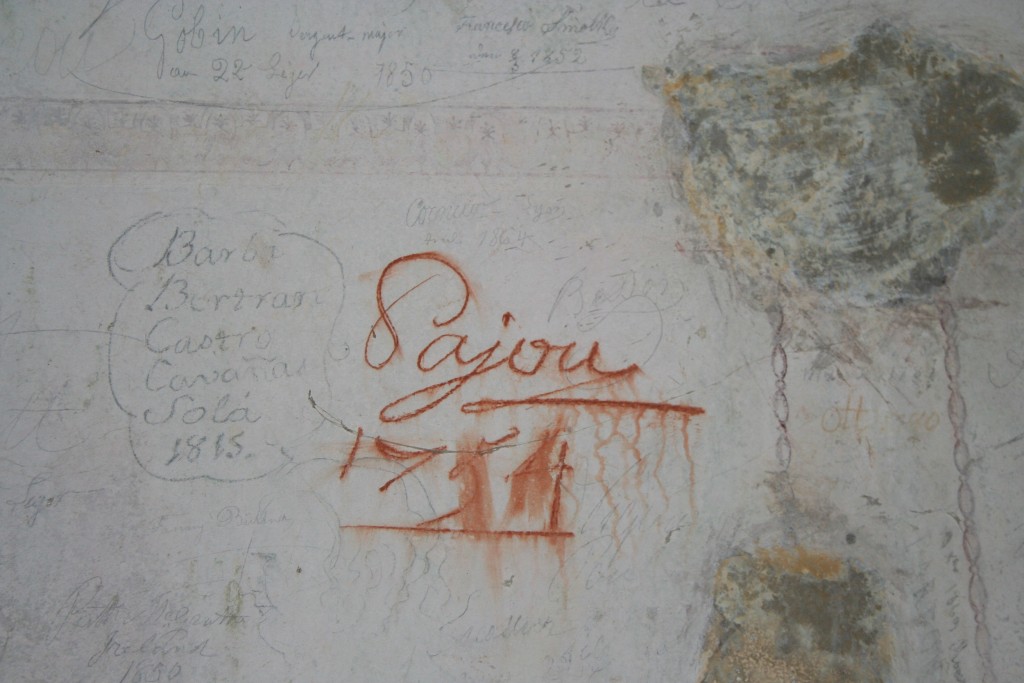
Fig. 6. Augustin Pajou’s signature from 1754 on the wall of Hadrian’s Villa, Tivoli. Photo by the author.
In 1754 the French sculptor Augustin Pajou (1730-1809) placed his signature on the ancient wall paintings of Hadrian’s Villa in Tivoli outside of Rome (Fig. 6). He was twenty-four years old, a young and promising winner of the Grand Prix de Rome (1748) and future officier of the Académie royale in Paris. His signature, traced in elegant red-chalk cursive letters, is exactly the same as the signatures he would later carve into his terracotta sculptures once he became an accomplished artist (Fig. 7), a similarity that is evident in the distinctive curl of the letter “p.” Although its lines have bled due to humidity, Pajou’s signature remains quite magnificent: it is the proud manifestation of a developing artistic self-consciousness. Moreover, as a draughtsman, red-chalk drawing remained one of Pajou’s preferred media.[23] Signing in Rome on such Antique masterpieces was a highly reflexive act for these artists: they were aware that by affixing their signatures they were articulating notions of appropriation, authorship, and embodied presence. In Rome, the art-historical canon was not only constructed on the surface of written pages, it was also concretely marked, emulated, and appropriated by artists and visitors. Pajou’s signature articulates the enactment of his artistic self on the ancient wall paintings he came to copy and with which he aspired to compete.
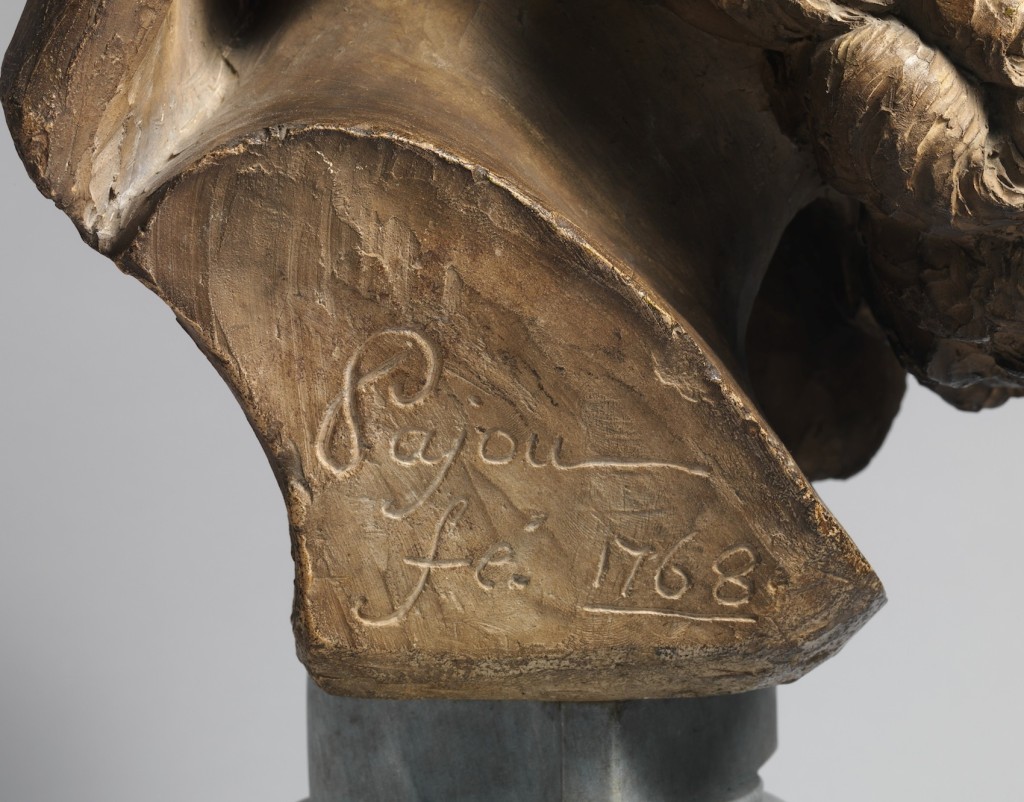
Fig. 7. Augustin Pajou, Head of a Bearded Elder (detail of the signature), 1768. Terracotta. The Metropolitan Museum of Art. Purchase, Lila Acheson Wallace Gift, 2003. www.metmuseum.org.
Because it conveys a strong bodily presence, graffiti palpably demonstrates how the art historical canon was not only written in paper but also performed by artists and visitors. These marks are traces of corporeality, rather than simply records of viewing. The surface of things, or patina as we might call it, tells us much about the way people handled them. But how are we to describe someone who is not only a viewer or a spectator, but instead someone who circulates around the artwork, touches it, and engages with its materiality? There is no term for such an actor in an art history that has privileged a neo-Vasarian, idealized approach to art.
Today graffiti evokes ideas of transgression or political revolution. In the early modern period, and still in the eighteenth century, graffiti on artworks or artistic monuments expressed the haptic and intimate experience of art, even in the most mechanical operations of copying and tracing. Graffiti also manifested a self-awareness on the part of artists about their own authorial status. Paying attention to materiality, scrutinizing the material surface of objects, allows us to think differently about art and about our own relationship to cultural heritage. Graffiti, in the past, expressed affiliation and shared aesthetic values. Cy Twombly perfectly expressed this idea in his School of Athens (1964; Gagosian Gallery, London). In this painting, Twombly, who lived for fifty years in Rome and died there in 2011, reveals his attentive study of Raphael’s fresco as well as a desire to pay tribute to Raphael through his own work. Some formal parallels (such as the allusion to the vault at the top of the composition) demonstrate his careful consideration of lines, drawings and forms in Raphael’s fresco. Through this engagement, he certainly placed himself within this lineage of Classicism, but he also looked at it as an archeologist, paying close attention to its scratched and colorful surface.
Across the painting, Twombly has scrawled the words “Scuola di Atene/Cy Twombly/Roma/ 1964.” These written words allude to those layers of dirty graffiti, tags, and dates – sometimes hardly legible – that cover the walls of the Raphael Rooms. Did Twombly leave his own tag there? I do not know. But via this allusion to the signatures left in the Raphael Rooms, the words within Twombly’s own painting come to function as graffiti: they testify to the artist’s personal affiliation with the School of Athens fresco, and his attempt to copy and emulate it. Just like Hubert Robert or his other predecessors more than two centuries ago, Twombly emphasized his material connection to the fresco and, in so doing, placed himself within this lineage of Classicism. By signing his name as if he were tagging, and by painting as if he were scribbling, Twombly succeeds in conveying the layered surface materiality of Raphael’s painting, so clearly tagged and scratched when seen from up close. But he also claimed a break with tradition: as his signature assumes the character of graffiti, Raphael’s own iconography is erased. What remains is the experience of the surface, the energy of the hand, the writing in pencil. Graffiti, now framed, becomes art.[24]
Charlotte Guichard is chargée de recherche at the Centre National de la Recherche Scientifique (Institut d’histoire moderne et contemporaine) in Paris
[1] Quoted in Lawrence Levine, Highbrow/Lowbrow: The Emergence of Cultural Hierarchy in America (Cambridge: Harvard University Press, 1990), 185.
[2] On this graffiti, see André Chastel, The Sack of Rome: 1527, trans. Beth Archer (Princeton: Princeton University Press, 1983). The present article is drawn from my book: Charlotte Guichard, Graffitis. Inscrire son nom à Rome, 16e-18e siècle (Paris: Le Seuil, 2014). I thank the editors of Journal18, the anonymous peer reviewers, and Kristel Smentek for their helpful comments on it.
[3] On religion and Renaissance art, see Hans Belting, Likeness and Presence: A History of the Image before the Era of Art (Chicago: Chicago University Press, 1996). On graffiti in the context of devotional practices, see Jérôme Baschet and Jean-Claude Schmitt, eds., L’image: Fonctions et usages des images dans l’Occident médiéval (Paris: Cahiers du Léopard d’Or, 1996); and Jean Wirth and Jean-Claude Schmitt, eds., Le Corps des images: Essais sur la culture visuelle au Moyen-Âge (Paris: Gallimard, 2002). For an exemplary study of devotional graffiti, see Véronique Plesch, “Body of Evidence: Devotional Graffiti in a Piedmontese Chapel,” in On Verbal/Visual Representation, Word & Image Interactions 4 (Amsterdam and Atlanta: Rodopi, 2005), 179-191. See also Jérémie Koering and Isolde Pludermacher, “Les graffitis d’artistes: signes de dévotion artistique, Rome, Latium, 15e-19e siècles,” Revue de l’art 184, no. 2 (2014): 25-34. For a more general approach on the recent historiography of graffiti, see Jeff Oliver and Tim Neal, eds., Wild Signs: Graffiti in Archaeology and History (Oxford: Archaeopress, 2010); and Guichard, Graffitis, introduction.
[4] Stéphane Loire, “Poussin chez Raphaël, 1627. Sur quelques graffiti d’artistes français à Rome,” in Mélanges en hommage à Pierre Rosenberg (Paris: Réunion des Musées Nationaux, 2001), 264-274. See also Nicole Dacos, “Graffiti de la Domus Aurea,” Bulletin de l’Institut historique belge de Rome 38 (1967): 145-175.
[5] Jean-Claude Bonnet, Naissance du Panthéon: Essai sur le culture des grands hommes (Paris: Fayard, 1998); Malcolm Baker, Figured in Marble: The Making and Viewing of Eighteenth-Century Sculpture (Los Angeles: J. Paul Getty Museum, 2000); and Erika Naginski, Sculpture and Enlightenment (Los Angeles: Getty Research Institute, 2009).
[6] Katie Scott, “Introduction. ‘Pour la gloire des arts et l’honneur de France.’ Commemorating Poussin 1784-1995,” in Commemorating Poussin: Reception and Interpretation of the Artist, ed. Katie Scott and Genevieve Warwick (Cambridge, Cambridge University Press, 1999), 1-20.
[7] Arjun Appadurai, The Social Life of Things. Commodities in Cultural Perspective (Cambridge: Cambridge University Press, 1988); Thierry Bonnot, La vie des objets (Paris: Éditions de la MSH et Mission du Patrimoine ethnologique, 2002).
[8] Jonathan Crary, Techniques of the Observer: On Vision and Modernity in the Nineteenth Century (Cambridge: MIT Press, 1991).
[9] “[D]ans l’intérieur de la balustrade étoient placés, raisonnablement éloignés les uns des autres, des fusiliers de la milice bourgeoise pour contenir l’indiscretion des curieux.” Siméon-Prosper Hardy, Mes loisirs ou Journal d’événements, Bibliothèque Nationale de France, ms. fr. 6687, fol. 909, mardi 1er septembre 1789. This manuscript is currently being prepared for publication at the Institut d’histoire moderne et contemporaine (Paris) under the direction of Pascal Bastien, Sabine Juratic, and Daniel Roche.
[10] “[D]es préposés attachés au Musée, auxquels on peut avec sûreté confier les cannes, sabres, manteaux, parapluies, qu’il est nécessaire de déposer avant d’entrer.” Explication des ouvrages de peinture et dessins… exposés au Museum central des Arts, an VI, avis, i. On the history of the Louvre, see Andrew McClellan, Inventing the Louvre: Art, Politics, and the Origins of the Modern Museum in Eighteenth-Century Paris (Cambridge: Cambridge University Press, 1994).
[11] Alexander Nagel and Christopher S. Wood, Anachronic Renaissance (New York: Zone Books, 2010).
[12] For this image and others commented on in this paper, see Guichard, Graffitis.
[13] Juliet Fleming, Graffiti and the Writing Arts of Early Modern England (London: Reaktion Books, 2001).
[14] Georges Didi-Huberman, ed., L’Empreinte (Paris: Centre Georges Pompidou, 1997).
[15] Georges Didi-Huberman, Devant le temps: Histoire de l’art et anachronisme des images (Paris: Éditions de Minuit, 2000).
[16] “Les pensionnaires du roi à l’Académie de France étaient occupés en 1740 à calquer à voile ces belles peintures du Vatican, & à les peindre ensuite, pour servir à faire des tapisseries aux Gobelins (…) Pour lever exactement ces peintures au voile, on étend sur l’original une gaze claire où l’on trace le contour des figures, & on le rapporte ensuite sur la toile imprimée.” Joseph-Jérôme de La Lande, Voyage d’un François en Italie… (Paris: Desaint, 1769), vol. 3, 178.
[17] “[U]ne sorte de rivalité sans jalousie, une lutte entre des hommes vertueux qui se disputent le succès dans un projet louable. L’artiste languit s’il n’est pas excité par l’émulation mais il ne suffit pas que les élèves se proposent des rivaux dans leur école, & les maîtres entre leurs contemporains. (…) L’émulation doit régner entre les artistes vivans & les plus grands des artistes qui ne sont plus. (…) Osez provoquer au combat les maîtres les plus difficiles à vaincre. Traitez un sujet que l’un d’eux ait manié avant vous, & redoublez d’efforts pour l’emporter sur lui. Si vous traitez un sujet différent, supposez que votre tableau sera exposé en pendant avec un tableau de Raphael, du Dominiquin, du Titien, de Rubens.” Claude-Henri Watelet and Pierre Levesque, eds., Encyclopédie méthodique (Paris: Panckoucke, 1788), t. 1, Beaux-arts, entry on “Emulation,” 246.
[18] Katie Scott, “Emulation: Anxieties of Influence and the Progress of Plagiarism in Eighteenth-Century French Art,” conference paper delivered at Centre allemand d’histoire de l’art, Paris, March 11, 2014.
[19] Svetlana Alpers, The Art of Describing: Dutch Art in the Seventeenth Century (Chicago: Chicago University Press, 1983).
[20] Lorne Campbell, National Gallery Catalogues: The Fifteenth Century Netherlandish Paintings (London : National Gallery Company, 1998), 200. See also my discussion of the painting (and the debates on it) in Graffitis, chapter iv: “Hors du cadre, la signature de l’artiste.”
[21] Louisa C. Matthew, “The Painter’s Presence: Signatures in Venetian Renaissance Pictures,” The Art Bulletin 80, no. 4 (December 1998): 616-648.
[22] Béatrice Fraenkel, La signature: Genèse d’un signe (Paris: Gallimard, 1992); Ewa Lajer-Burcharth, “Image Matters: The Case of Boucher,” in Dialogues in Art History, from Mesopotamian to Modern: Readings for a New Century, ed. Elizabeth Cropper (New Haven and London: Yale University Press, 2009), 277-303; Charlotte Guichard, “La main et le geste. Autographie et signature au 18e siècle,” in De l’authenticité: Une histoire des valeurs de l’art (xvie-xxe siècle), ed. Charlotte Guichard (Paris: Publications de la Sorbonne, 2014), 63-79.
[23] James David Draper and Guilhem Scherf, eds., Augustin Pajou: Royal Sculptor, 1730-1809 (New York and Paris: Musée du Louvre and Metropolitan Museum of Art, 1997). Thanks to Edouard Kopp for this suggestion.
[24] Roland Barthes, “Cy Twombly ou ‘Non multa sed multum’,” in Catalogue raisonné des oeuvres sur papier de Cy Twombly, ed. Yvon Lambert (Milan: Multipha, 1979), vol. 6, 1973-1976, 7-13.
Cite this article as: Charlotte Guichard, “Scratched Surfaces: Artists’ Graffiti in Eighteenth-Century Rome,” Journal18, issue 1 (Spring 2016), https://www.journal18.org/420. DOI: 10.30610/1.2016.2
Licence: CC BY-NC
Journal18 is published under a Creative Commons CC BY-NC International 4.0 license. Use of any content published in Journal18 must be for non-commercial purposes and appropriate credit must be given to the author of the content. Details for appropriate citation appear above.

